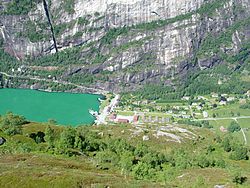Forsand
| Forsand kommune | |||
|---|---|---|---|
| Municipality | |||

Lysebotn, located at the head of the Lysefjorden
|
|||
|
|||
 Forsand within Rogaland |
|||
| Coordinates: 59°00′49″N 06°25′28″E / 59.01361°N 6.42444°ECoordinates: 59°00′49″N 06°25′28″E / 59.01361°N 6.42444°E | |||
| Country | Norway | ||
| County | Rogaland | ||
| District | Ryfylke | ||
| Administrative centre | Forsand | ||
| Government | |||
| • Mayor (2015) | Bjarte Sveinsvoll Dagestad (H) | ||
| Area | |||
| • Total | 780.05 km2 (301.18 sq mi) | ||
| • Land | 701.30 km2 (270.77 sq mi) | ||
| • Water | 78.75 km2 (30.41 sq mi) | ||
| Area rank | 139 in Norway | ||
| Population (2015) | |||
| • Total | 1,208 | ||
| • Rank | 386 in Norway | ||
| • Density | 1.7/km2 (4/sq mi) | ||
| • Change (10 years) | 9.6% % | ||
| Demonym(s) | Forsandbu | ||
| Time zone | CET (UTC+1) | ||
| • Summer (DST) | CEST (UTC+2) | ||
| ISO 3166 code | NO-1129 | ||
| Official language form | Nynorsk | ||
| Website | www |
||
|
|
|||
Forsand is a municipality in Rogaland county, Norway. It is located in the traditional district of Ryfylke. The administrative centre of the municipality is the village of Forsand. Other villages in the municipality include Lysebotn, Øvre Espedal, Oanes, Kolabygda, and Fløyrli.
Forsand municipality surrounds the famous Lysefjorden and it lies on the east side of the Høgsfjorden. It is one of largest municipalities within the county of Rogaland in terms of area, and one of the smallest in terms of population. Forsand municipality covers 780 square kilometres (300 sq mi) and has a population of 1,208 (as of 2015). In 1999, evidence of a population here dating back to around 7500 BC was located.
The municipality of Fossan was established on 1 January 1871 when the very large municipality of Høgsfjord was divided into two: Fossan (located east of the Høgsfjorden and south of the Frafjorden) and Høle (located west of the Høgsfjorden). Initially, Fossan had 2,081 residents. On 1 January 1965, the municipality was split, with everything located south and east of the Frafjorden being transferred to the neighboring municipality of Gjesdal. This area had no road connection with the rest of Forsand, but it was connected by road to Gjesdal.
The municipality (originally the parish) is named after the old Forsand farm (Old Norse: Forsandr), since the first Forsand Church was built there. The first element is the prefix for which means "outsticking" and the last element is sandr which means "sand" or "sandy beach". Before 1918, the name was written "Fossan".
...
Wikipedia


